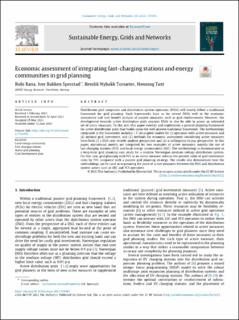| dc.contributor.author | Rana, Rubi | |
| dc.contributor.author | Sperstad, Iver Bakken | |
| dc.contributor.author | Torsæter, Bendik Nybakk | |
| dc.contributor.author | Taxt, Henning | |
| dc.date.accessioned | 2024-01-22T09:16:34Z | |
| dc.date.available | 2024-01-22T09:16:34Z | |
| dc.date.created | 2023-06-15T12:18:03Z | |
| dc.date.issued | 2023 | |
| dc.identifier.issn | 2352-4677 | |
| dc.identifier.uri | https://hdl.handle.net/11250/3112978 | |
| dc.description.abstract | Distribution grid companies and distribution system operators (DSOs) still mostly follow a traditional framework for grid planning. Such frameworks have so far served DSOs well in the economic assessment and cost–benefit analysis of passive measures, such as grid reinforcement. However, the development towards active distribution grids requires DSOs to also be able to assess an extended set of active measures. To this aim, this paper extends and implements a general planning framework for active distribution grids that builds upon the well-proven traditional framework. The methodology integrated in the framework includes: (1) decoupled models for (i) operation with active measures and (ii) optimal grid investment, and (2) methods for economic assessment considering active measures from both (i) a DSO cost–benefit analysis perspective and (ii) a willingness-to-pay perspective. In this paper, operational models are integrated for two examples of active measures, namely the use of fast-charging stations (FCS) and local energy communities (LEC). The methodology is demonstrated in a long-term grid planning case study for a realistic Norwegian medium voltage distribution system. For this case, grid planning with FCS as an active measure reduces the present value of grid investment costs by 70% compared with a passive grid planning strategy. The results also demonstrate how the methodology can be used in negotiating the price of active measures between the DSO and distribution system actors such as LEC and FCS operators. Keywords Local energy communityFast-charging stationActive grid planningGrid development plan | en_US |
| dc.description.abstract | Economic assessment of integrating fast-charging stations and energy communities in grid planning | en_US |
| dc.language.iso | eng | en_US |
| dc.publisher | Elsevier | en_US |
| dc.rights | Navngivelse 4.0 Internasjonal | * |
| dc.rights.uri | http://creativecommons.org/licenses/by/4.0/deed.no | * |
| dc.title | Economic assessment of integrating fast-charging stations and energy communities in grid planning | en_US |
| dc.title.alternative | Economic assessment of integrating fast-charging stations and energy communities in grid planning | en_US |
| dc.type | Peer reviewed | en_US |
| dc.type | Journal article | en_US |
| dc.description.version | publishedVersion | en_US |
| dc.rights.holder | The Authors | en_US |
| dc.source.volume | 35 | en_US |
| dc.source.journal | Sustainable Energy, Grids and Networks | en_US |
| dc.identifier.doi | 10.1016/j.segan.2023.101083 | |
| dc.identifier.cristin | 2154825 | |
| dc.relation.project | Norges forskningsråd: 308833 | en_US |
| dc.relation.project | Norges forskningsråd: 295133 | en_US |
| dc.relation.project | Norges forskningsråd: 257626 | en_US |
| dc.source.articlenumber | 101083 | en_US |
| cristin.ispublished | true | |
| cristin.fulltext | original | |
| cristin.qualitycode | 1 | |

